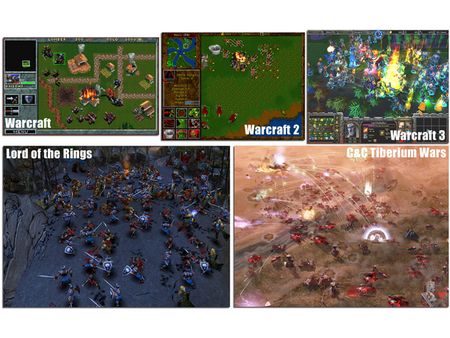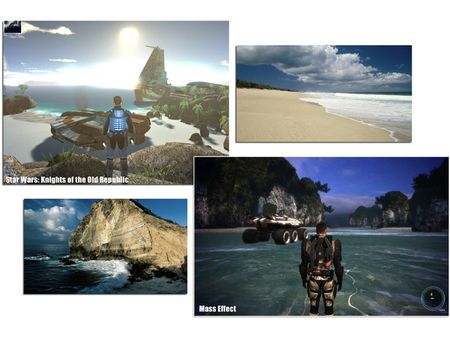Reality Check: 3D Graphics Take On Hollywood
Game Evolution
Real-time strategy games have been through a fascinating development. The graphics have arguably made the greatest progress, the controllers are constantly being improved, but options and ideas have stagnated somewhat in the last few years, giving many gamers the impression that everything was better in the past.
Warcraft took the world by storm in 1994. The simple graphics were given a sidelong point of view and fixed, painted on shadows were added to make things look more plastic. The sequel came along in 1995; the graphics were slightly improved, but the greatest change was a higher resolution, which made the pixels more fine. This was a necessary move, particularly for the text. Real 3D graphics hadn’t even been considered yet. They first appeared with the third part of the series in 2002—immediately you noticed that the environment and the figures all appeared to have fallen into a paint box. Everything was super-colorful and lively, every effect had to be demonstrated optically. Magic and special abilities lit up and the game sparkled and glittered all over the place.
Further developments in real time strategy games toned down the bright colors a little, improved the level of details on the figures and made it all look a little more natural. Individual characters could be identified by their equipment, you could zoom in and out of the world, and the number of troops increased dramatically. However, the CPU did a lot of this work. Locating the hordes, calculating the artificial intelligence, and managing the increased number of individual units requires a lot of power. And a modern graphics cards must have the resources to be able to draw the shader effects quickly enough. Current games like World in Conflict are putting more emphasis on lighting effects, serious explosions, realistic smoke, rays of sunlight, and large water surfaces.
3D games must develop quicker and be more closely based on nature. Graphics makes rapid progress, thanks to the new shader effects. Water looks very professional, weather effects and sunshine look much more natural. The film filter in Mass Effect is somewhat contended—the more crude granulation creates an element of blur which leads to a little less focus on edges and colors. This makes both the environment and people very realistic, but not everyone finds this blur to their liking.
Get Tom's Hardware's best news and in-depth reviews, straight to your inbox.
Current page: Game Evolution
Prev Page Using Nature As The Template Next Page Lighting And Dazzle Effects-
jimmysmitty Of course it can always get better. it just depends on how much of the power available to them the game designers want to use. For PC its harder though since they want the most sales and want to go from low to high end.Reply
Introducing MT in games would boost FPS allowing more and better eye candy.
A good example is L4D from VALVe. Source is a 4 year old engine but some of the graphics in that game are close to Crysis which is amazing to be honest since Crysis was made with a much newer engine.
It is also rumored to include MT capabilities. Will have to see.
Once game designers stop worrying as much they will finalyl make better looking games. As you can see from Far Cry 2 though the PC looks to have much superior graphics for it. The 360 version looks a bit bland where as the PC version looks nice and gritty. -
V3NOM yaya dx 11... cant wait to spend another $100 on another OS and $500 for a new graphics setup which will then be incompatible with something therefore resulting in a whole new $1000+ system. who wouldn't want to?Reply -
safcmanfr V3NOMyaya dx 11... cant wait to spend another $100 on another OS and $500 for a new graphics setup which will then be incompatible with something therefore resulting in a whole new $1000+ system. who wouldn't want to?Reply
Shows how much you read up about DX11. It will be compatible on Vista and Windows 7 - so no need to update your OS. Unless you still use XP, which is your choice and you just need to live with the consequences.
Yes you will need a new GPU - but if you are a serious gamer you probably buy one of those every 9-12 months anyway. and $500? for the very top end perhaps - but why not go for the equivalent of the 4870 when dx11 comes out - which is $250? -
enewmen Thanks for the article.Reply
I hope to see realistic/possible samples of future(1-4 years) screenshots in another article. -
As a researcher in the field of computer graphics, I can safely say that we haven't seen the end of it. Yes, a lot of hope has to be put on faster hardware. And lets face it - light is a tricky business...you do not think about it, but the complexity of the processes involved that enable you your eyesight is enormous.Reply
Yet, every now and then a new algorithm is developed, which introduces more accuracy and less approximations, which runs faster and more optimal. It is not yet sure which idea will prevale (ray tracing or raster or something else), but it is sure that visible pixelization, coarse models, unrealistic lighting etc are going to be pretty much the past. When? Nobody can honestly answer this question...lets wait and see. -
dobby safcmanfrReply
actually it get better still, acording to all currently known info, direct3D 11 will be perfectly backward compatible with both vista and win7, but also the infrastructure of DX10 and DX10.1 GPU's will be able to support directX 11.
see: http://en.wikipedia.org/wiki/DirectX#Direct3D_11
^and yes i do know that wiki isnt the great source, but it is as good as any.
although the way the article is worded, it is made to sound as though some of the more subtle effect would require an upgrade. however the import part is GPGPU support accross both nvidia and ATi, and multithreading which will be supported.
-
caamsa ReplyAs a researcher in the field of computer graphics, I can safely say that we haven't seen the end of it. Yes, a lot of hope has to be put on faster hardware. And lets face it - light is a tricky business...you do not think about it, but the complexity of the processes involved that enable you your eyesight is enormous.
Well it took evolution billions of years to perfect the human eye so I think we can cut you programmers a break ;-) so far most of the new games look great.
I enjoy good looking games but the games need to have some substance to them as well. No one wants to play a crappy game no matter how good it looks.
-
WyomingKnott Either most of the illustrations also include a real photograph, or there is some incredible quality out there. In the illustration "Targeted use of light sources lighting up a grid structure," is the upper-right image, an outside view of a window with bars, a real photo? If not, let me know what game it is from and I will buy it.Reply -
neiroatopelcc Even with all those effects I'm still marvelled by the lack of realistic structures. I do have a gaming rig with sufficient power to play crysis and what not, but still I can't find a game where walls don't look unnaturally sharp edged.Reply
No matter how much soft shadow, af or aa is applied, it still manages to look like a building is simply 4 completely straight walls. Even when you blow something up in the newest crysis game you'll notice that a building is made up of incredibly straight sheets of wood or metal. Sure they've come a long way with foilage and stuff, but hollywood knows a great deal more about realistic structures than game developers seem to do.

